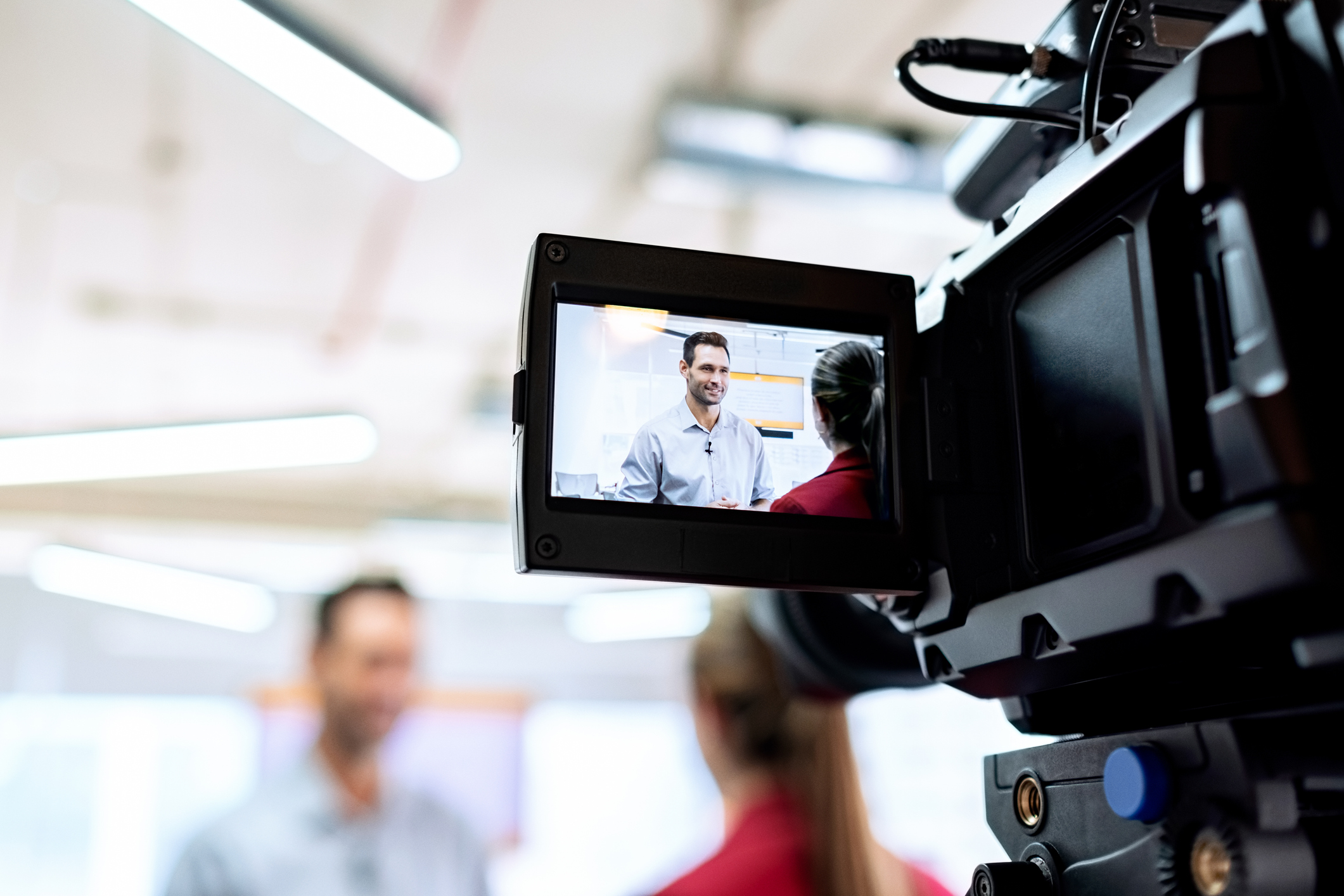July 8, 2019
 by Taru Bhargava / July 8, 2019
by Taru Bhargava / July 8, 2019

From 467 million users in Q3 2016 to 590 million by the end of 2018, LinkedIn’s growth has been phenomenal.
It’s safe to say that we've come a long way from the days when the platform was considered a dumping ground for resumes and pushing content in groups.
The site’s growth is due to features designed to increase engagement. And the one feature that’s caught everyone’s attention? LinkedIn Videos.
If you’re a B2B marketer looking to connect with an audience and generate new leads (who isn’t?) LinkedIn Video presents a great opportunity.
In this post, I’m going to dive deep into this feature and evaluate how B2B marketers can plan their video strategy. But before we go ahead, let’s take a minute to evaluate the scope of LinkedIn videos for B2B marketers.
Are LinkedIn videos worth the time and effort for B2B marketers?
Now, LinkedIn has always been a natural choice for B2B marketers—the platform offers a fine balance between professionalism and creativity, which makes it a perfect playground to test new content formats.
When you throw the magic of video-based content into the mix, we’ve got ourselves a winner!
In fact, research shows that LinkedIn video posts earn three times more engagement than text posts. Additionally, early findings from LinkedIn’s beta program reveal that native videos have five times more potential to start a conversation amongst members.
But that’s not all.
While chatting with Michael Stelzner, Goldie Chan, a social media strategist, talked about how effective LinkedIn videos are for B2B businesses:
“About 45% of all B2B buyers make purchasing decisions based on LinkedIn content. So if you’re on LinkedIn and you’re a B2B marketer, you have a good chance of reaching people who could help you move sales.”
Wistia, a video hosting company, used LinkedIn native videos to push their Video Marketing Week. Dubbing the strategy “LinkedIn video takeovers,” the company asked its employees to record short videos promoting the event. The results? Video Marketing Week gained over 100 new signups through this campaign.
Clearly, LinkedIn videos are a winner.
Now that we’ve got a seal of approval, let’s look at what an effective B2B LinkedIn video strategy entails.
How can B2B marketers ensure that their content is top-notch?
It’s simple: by creating content that resonates on this platform. This requires a solid content marketing strategy for LinkedIn. Here are the three steps to put it into action:
Before you jump on planning a LinkedIn video strategy, stop and think of who makes up the majority of your audience. Creating your content for the “professional community” is a very basic, generic approach—you need to know exactly who they are and what resonates with them.
Here’s some research by LinkedIn that can help you lay the basic groundwork.
The two most prevalent groups on the platform are Millennials and Gen Xers. According to surveys conducted by LinkedIn, these two demographic groups consume content differently. The graphic below lists some of those differences:
While millennials are after content that’s educational, informative, and helpful, Gen Xers are interested in content that’s personally relevant and helps them stay on top of trends.
That’s great insight, but is there a way to get more granular? Like really, really nail down your audience? Absolutely!
Adding the LinkedIn Insight Tag to your website will not only help you understand your audience better but also create tailored content and swiftly reach your ideal audience. What does adding the tag entail? Just copying and pasting a few lines of code—that’s all that’s needed to give you deep insights about your audience!
|
TIP: Businesses and sales teams can find the right people at the right accounts when they integrate LinkedIn Sales Navigator by matching qualified prospective companies on G2 with Recommended Leads that fit their ideal customer profile so that you can develop your videos to be curated to the best possible persona. |
Now that you understand how people use LinkedIn, let’s look at the next step—developing content that really matters to your audience.
The question is: What does engaging content look like, and what’s the best framework for creating it consistently?
It’s clear from the above graphic that professionals value content that’s informative, relevant, and inspiring. These characteristics form the foundation of the content marketing honeycomb, a framework for high-value content that prioritizes these characteristics: participatory, entertaining, helpful, educational, unique, meaningful, and educational.
Here’s what it looks like:
If you look at a LinkedIn video with massive engagement, you’d see that it has at least two or three of the honeycomb characteristics. B2B marketers should aim for the same (and more!).
If your content is helpful, can you also make it entertaining? If it’s educational, can you find a way to make it participatory, too?
For inspiration, here are three examples from B2B SaaS companies:
Key characteristics: Participatory and meaningful
Steli Efti, CEO of Close, used LinkedIn native video to seek candidates for an open marketing position.
While Efti’s post is HR-driven, his connections (and prospects) did get a glimpse of what’s happening in the company and how they are growing! Who wouldn’t want to do business with a team like that?
| TIP: LinkedIn Premium offers many features to help grow and promote your brand far and wide. |
Key characteristics: Meaningful, educational, and helpful
Appcues, a customer experience software service, is using LinkedIn videos to plug their new Product-Led Growth resources.
Key characteristics: Meaningful, unique, educational, and helpful
Sharing expertise is the norm, but rarely do B2B brands give advice to their peers about topics unrelated to their own products or services. For example, a recruiting company typically sticks to the realm of HR, rather than offering their two cents on digital security. However, given that your peers are also decision-makers, addressing the challenges you have in common is a novel way of building conversations and connections.
The team at Nextiva, a business communications company, has championed this strategy. Here’s a video in which the team offers advice based on their own experiences with content marketing:
The bottom line? By creating thoughtful videos, you are addressing your prospective buyers’ needs and giving them an opportunity to connect with you on a much deeper level. Not only that, but you’re starting a conversation that actually engages people. B2B marketers can use the content honeycomb model to guide discussions as they generate, evaluate, and push their LinkedIn video ideas to the next level.
You know your audience and you know the kind of content they want. Now it’s time to evaluate the best format to experiment with your LinkedIn videos.
LinkedIn videos have two formats that B2B marketers can choose from:
Native video is uploaded directly to LinkedIn from a computer or mobile phone, or recorded via the app. These can be up to 10 minutes long, be either horizontal or vertical, and auto-play silently in a user’s feed.
Here’s LinkedIn native video in action:
Non-native or embedded videos are created and uploaded outside the platform. This includes videos published on Vimeo or YouTube and then shared on LinkedIn.
Here’s what non-native videos/embedded videos look like:
While both video formats are designed to engage, LinkedIn’s algorithm favors native video. These videos play more quickly, which results in more views and engagement.
And now the last step: making the end experience delightful.
Why is that so important? Because no one wants to waste their time looking at poorly edited or lackluster videos.
Like other social media platforms, LinkedIn has some best practices for video. B2B marketers who are keen to experiment with videos (both native and non-native) should adhere to these guidelines and tips.
Here’s what you should know when uploading a native video:
|
Related: Interested in other ways to edit your video for LinkedIn? Check out this roundup of the best video editing software! |
.png?width=512&name=unnamed%20(1).png)
It’s also advisable to add subtitles to your videos. Subtitles speed up comprehension as well as come in handy for people who want to watch videos minus the sound.
There you have it: four steps to creating LinkedIn videos that will attract clicks and leads.
But don’t stop just yet. When sharing your videos (native or not), couple them with a post that has a strong copy, relevant hashtags, and mentions. Such posts are favored by the site’s latest algorithm as they attract more conversations.
Here’s an example:
People who visit LinkedIn do so for a reason. It’s not just a spot for killing time, it’s a place to build relationships and grow professionally.
Given that the consumption of video-based content is on the rise, there’s a huge opportunity for B2B marketers to jump on the LinkedIn video bandwagon and add value to their audience. If used effectively, this channel can attract, engage, and convert new leads for your B2B business in no time. It is a medium with the potential to tell unique stories and have a lasting impact on potential customers.
The question is: are you ready to give this memorable medium a shot?
Use the tips and tools I shared above to get started and get ready to see engagement like never before.
Taru is a Content Marketer at Genbook and combines her expert skills in content strategy and SEO to drive more high-intent organic traffic for the company. When she’s not working, she’s busy cooking and raising her tiny dragon. Mindy Kaling is her cousin.
A stand-out product video compels consumers to pay attention.
 by Cristian Stanciu
by Cristian Stanciu
It's February, and that means you're probably halfway through the implementation phase of your...
 by Kai Tomboc
by Kai Tomboc
From bad acting to boring content, training videos can sometimes get a bad reputation.
 by Mara Calvello
by Mara Calvello
A stand-out product video compels consumers to pay attention.
 by Cristian Stanciu
by Cristian Stanciu
It's February, and that means you're probably halfway through the implementation phase of your...
 by Kai Tomboc
by Kai Tomboc


